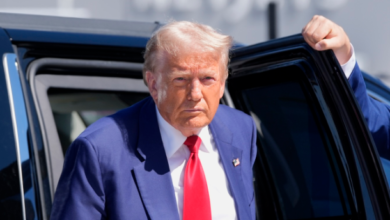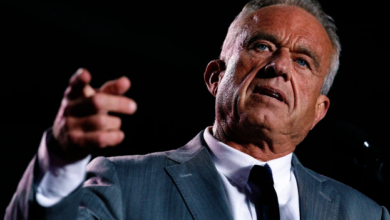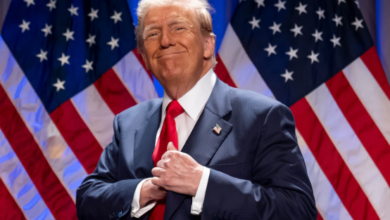Far-Right Hindu Nationalism Is Gaining Ground In The U.S.

HOBOKEN, N.J. — Audrey Truschke, a professor of South Asian history at Rutgers University, never thought her work could result in death threats and vicious vitriol.
Yet Truschke, a scholar, mom, wife and author of three books, now sometimes needs armed security at public events.
The publication of her first book, in 2016, challenging the predominant perception of 16th- and 17th-century Mughal kings — Muslim rulers who are widely vilified by Hindu nationalists — put a target on her back. Her email was bombarded with hate mail. Her Twitter account was inundated with threats. People wrote letters to news outlets about her.
“It felt like the world exploded at me,” said Truschke, pushing back her dark hair to reveal the salt and pepper streaks that frame her face. “This was my first brush with hate email. I’m sure it would seem like nothing to me now.”
Far-right Hindu nationalism, also referred to as Hindutva, is a political and extremist ideology that advocates for Hindu supremacy and seeks to transform a secular and diverse India into an ethnoreligious Hindu state. Hindu nationalism has been around for over 100 years and was initially inspired by ethnonationalism movements in early 20th-century Europe, including those in Germany and Italy. Champions of Hindutva have viciously targeted religious minorities including Muslims, Christians and Sikhs, and have sought to silence critics such as academics and activists.
Hinduism, the faith, is not Hindutva the far-right movement. But the label Hindu can be categorized as a religious, political or racial identifier depending on who is using it, explained Manan Ahmed, a professor and historian of South Asia at Columbia University. Hindu nationalists, he said, are morphing the religious, political and racial into one identity in order to advance a supremacist, majoritarian agenda.
People impacted by Hindutva in the U.S. say the movement has crept into their hometowns and workplaces, making life more dangerous for them and threatening to make their communities less diverse and tolerant. The ideology has deep ties to white nationalist movements across the globe, and the targets of nationalist groups warn that the impact could be deadly if Hindutva is not addressed and defeated.
“We see Hindu nationalism as an ideology which seeks to transform India from a pluralistic secular democracy to a Hindu state in which non-Hindus are seen at best as second-class citizens and at worst targets for extermination and disenfranchisement of all sorts,” said Nikhil Mandalaparthy, the deputy executive director of Hindus for Human Rights, a nonprofit organization dedicated to promoting pluralism and human rights in South Asia and in the U.S.
“It’s a vision that we think is in direct opposition to a lot of the values of Hindu religious traditions,” he added.

Natalie Keyssar for HuffPost
A Different Kind Of Extremism
In India, Hindu nationalism can be traced back to the 1920s. The formation of the Rashtriya Swayamsevak Sangh, or RSS, in 1925 fortified the core belief in a Hindu state for Hindus, despite India’s secular constitution and the long history of ethnic and religious minorities in the country. The RSS has been banned three times since it was established, including after a former party member assassinated Mahatma Gandhi in 1948.
It was out of the RSS that India’s ruling political party, the Bharatiya Janata Party, or BJP, emerged. It has held power since Prime Minister Narendra Modi was elected in 2014.
Since then, the crackdown on India’s minorities, particularly Muslims, has intensified with little to no accountability.
In April, bulldozers razed houses in majority-Muslim neighborhoods under dubious pretenses. Schools have banned Muslim students from wearing a hijab. Courts and government bodies have overturned convictions or withdrawn cases that accused Hindus of involvement in violence against Muslims. Hindu mobs routinely attack Muslims with little to no condemnation from the government.
“Hindu nationalism has redefined the Indian mainstream,” Truschke said. “It’s an incredible success story. Fifty years ago, no respectable Indian wanted to touch it. It was just completely verboten due to the Hindutva embrace of violence and hate, and now it’s the dominant political position in India.”
Other parts of the world, including the U.S., have not been immune to growing support for Hindutva.
Indian Americans make up the second-largest immigrant group in the United States, with nearly 4.2 million people of Indian origin living in the country, according to data from the Carnegie Endowment for International Peace. The community is a diverse one, comprising both immigrants and American-born citizens who come from a variety of religious and socioeconomic backgrounds. The Carnegie poll indicates that at least 54% of Indian Americans report belonging to the Hindu faith, one of the largest and oldest religions in the world. There are about 1 billion Hindus around the world, and nearly 94% live in India. Around 2.5 million Hindus reside in the U.S. alone.
Indian Americans hold mixed opinions on the present trajectory of India’s democracy, but nearly half — particularly Republicans, Hindus and those not born in the U.S. — approve of Modi’s performance as India’s prime minister. In Texas, more than 50,000 people gathered to see him during a 2019 event called “Howdy Modi.”
In many ways, the rise of Hindu nationalism mirrors the rise of white nationalist extremism.

OLE BERG-RUSTEN via NTB/AFP via Getty Images

Jeff J Mitchell/Getty Images
Anders Behring, the far-right Norwegian terrorist who killed 77 people, many of them teenagers, in 2011, reportedly praised Hindu nationalist groups who attacked Muslims in his manifesto.
Vinayak Damodar Savarkar, an Indian politician who became the face of Hindu nationalism in the 1920s, once applauded Hitler and said that India should treat Muslims the same way Nazis treated Jews.
Like white supremacists, Hindu nationalists have propagated a revisionist history built on the idea that India, despite its secular constitution, once was and should still be a Hindu state and that members of other religious groups are not true natives of the country.
“When we talk about threats to democracy and threats to multicultural, pluralist, way of life, of course, here in the U.S., our concern is white supremacy and Christian nationalism,” Mandalaparthy said. “But there are so many ways in which the Hindu nationalist movement here is trying to ally itself with white supremacist groups and with groups who are seeking to destroy democracy here in this country.”
Many Indian Americans, including those who are Hindu, have faced hate crimes and discrimination as minorities in the U.S. But Hindu nationalists often use “Hinduphobia” as a disingenuous claim to shut down valid criticism of Hindu nationalist political ideology, Mandalaparthy said.
“It’s dangerous to contribute to this narrative of rising anti-Hindu sentiments because the people who are using this language the most are then turning back on members of our own communities and those who speak out against Hindu nationalism or caste or Islamophobia,” he said.
“There are so many ways in which the Hindu nationalist movement here is trying to ally itself with white supremacist groups and with groups who are seeking to destroy democracy here in this country.””
– Nikhil Mandalaparthy, deputy executive director of Hindus for Human Rights
Support of Hindutva can take various forms, whether it’s applauding the violence taking place in India on social media or funneling donations to political figures who praise Hindu nationalism. At least five American organizations with ties to Hindu nationalist groups receive federal funding, according to a report by Al Jazeera.
It can also mean threatening people who raise awareness about the ideology.
In March 2021, two months after Truschke began researching U.S.-based Hindu nationalism, she began to receive an onslaught of attacks. She had received hate mail before, particularly after her book revisiting the legacy of Aurangzeb, a contentious emperor who ruled India for nearly 50 years.
But the severity of the new attacks, which Truschke said felt unprovoked, was unprecedented. She received a staggering amount of hate mail and tweets, with about one tweet coming in every minute, she said. People made memes out of her photos and laced their messages with antisemitism and misogyny. They threatened her and her children, promising they’d find her family if she continued to speak out.
She reported several threats to the police, and one was even forwarded to Homeland Security last July. After receiving several credible threats, venues that hosted Truschke hired armed security to be by her side at public events.
“Keep loving Mughals and we’ll keep loving Hitler you stupid jew,” read one tweet.
“I wouldn’t mind if this female bitch is beheaded,” read another comment.
“Be in your home, you don’t know from where you will be kidnapped,” read a message sent to her on Facebook.
“I will chop ur head if I get a chance,” read another.

Natalie Keyssar for HuffPost
In September 2021, organizers of an online academic conference on Hindutva were also bombarded with thousands of threats of rape, violence and death. Several participants withdrew from the conference out of fear. Dozens of organizers and speakers said violent threats were made against their families. More than 30,000 threats were sent to one university, causing the server to crash.
Data collected by Columbia University’s Ahmed and other researchers indicate that the majority of tweets deployed against the conference organizers and participants were generated by individuals, not bots.
It’s not just online threats. Tensions have manifested into bitter communal tension and physical clashes across the country. In New Jersey in August, organizers of the local India Day parade came under fire for bringing bulldozers — symbolic of the bulldozers that have targeted Muslims in India — adorned with the faces of Modi and the hard-line Hindutva BJP minister Yogi Adityanath.
That same month in Anaheim, California, an Indian Independence Day parade turned physical when videos captured men shoving a group of protesters while shouting Islamophobic slurs and nationalists chants.
The alignment between Hindu nationalism and right-wing nationalist groups is flourishing in the U.S., which “doesn’t bode well for any marginalized groups,” Mandalaparthy said. “This is very much a domestic issue now and it’s very much a local issue.”
In many cases, those carrying out violence against religious minorities — Muslims, but other religious groups as well, including Christians, Sikhs and Dalits — feel direct support from India’s governing party. The United States Commission on International Religious Freedom, a government agency, recommended this year that India be put on its red list for “severe violations of religious freedom.”
“The government continued to systemize its ideological vision of a Hindu state at both the national and state levels through the use of both existing and new laws and structural changes hostile to the country’s religious minorities,” the commission said in its report.

SANJAY KANOJIA via Getty Images

Salman Ali/Hindustan Times via Getty Images
Holding Onto Their Identity
For more than 30 years, Minhaj Khan, a 48-year-old software engineer from South Brunswick, New Jersey, has prioritized giving back to his Indian community. At first, it was in the form of charity, especially right after moving to the U.S. in the late 1990s. He visited India often, especially since his extended family and sister still resided there.
But soon that charity became advocacy, and advocacy became a personal responsibility. As an American, an Indian, and a Muslim, Khan couldn’t look away from the human rights violations happening in his home state.
“When we use our free speech here, it makes a difference on the other side of the world,” Khan said. “Nobody is better than us presenting these issues to the American people.”
Khan and Mohammed Jawad, the president of the Indian American Muslim Council, an advocacy organization, led a campaign against the bulldozer that was paraded in Edison, New Jersey, this summer. In the days after the parade, members of IMAC and other organizations met with members of the state’s Department of Justice and its Office of Homeland Security and Preparedness, as well as with the state attorney general’s office. The organization also raised concerns after a local church invited a Hindu nationalist to speak. The church later canceled the event.
The group’s work hasn’t gone unnoticed. The IAMC received a summons from one of India’s lower courts because of its activism, though it has no legal grounds in the U.S.
“If you like diversity, if you believe people who are different and who follow different religions should live together and that we are all Americans, Hindutva is a threat to that.”
– Audrey Truschke, professor of South Asian history at Rutgers University
Khan remembers harmony between his family and his Hindu neighbors when he was growing up in India.
“Muslims and Hindus, we were always together, side by side. They came to our place, we went to their place,” he said. “We never differentiated among ourselves. We lived comfortably.”
But with Hindu nationalism on the rise, those relationships are being strained, particularly in New Jersey, which has the largest South Asian population of any state in the U.S. In some cities in the state, South Asians make up around 40% of the population.
Khan adjusts the sleeves of his brown button-down that is cuffed at his elbows, revealing a green pattern that matches the color of his eyes. He is particularly concerned about how Hindu extremism will impact his children.
“I am incredibly proud to be an American Muslim. This is the land of freedom. This is the land of justice. I am a free Muslim. I can practice my faith here in America perhaps best as compared to anywhere on the planet. I am equally proud of my Indian origin, the land of my birth,” Khan said. “That is why it pains us to witness the current regime in India trying to take away the most beautiful aspect of the land — its richness, diversity and inclusivity — and now export it even to America.”
For Truschke, the attacks on her life and on her work have only emboldened her to pursue her work head-on. Instead of focusing only on history, she is currently dedicating a research project to the present and the future of Hindu nationalism in the U.S.
Academic freedom, an uptick in violence, and increasingly polarized communities are all major concerns, she said. Truschke and her colleagues worked with a group called the South Asia Scholar Activist Collective to publish the Hindutva Harassment Field Manual, a resource for academics and others whose work may make them targets of the Hindu nationalist movement.
“Hindu nationalism is threatening American multicultural values,” Truschke said. “If you like diversity, if you believe people who are different and who follow different religions should live together and that we are all Americans, Hindutva is a threat to that, and it is growing. It is not going away. It’s likely to get worse.”

Natalie Keyssar for HuffPost
Hindu nationalists have targeted Truschke’s employer and colleagues over her work. Rutgers University told HuffPost in an emailed statement that it stood by Truschke’s work, saying “scholarship is sometimes controversial, perhaps especially when it is at the interface of history and religion, but the freedom to pursue such scholarship, as Professor Truschke does rigorously, is at the heart of the academic enterprise.”
“Just as strongly, Rutgers-Newark emphatically affirms its support for all members of the Hindu community to study and live in an environment in which they not only feel safe, but also fully supported in their religious identity,” the statement continued.
Truschke’s eldest daughter is starting to notice that her mother is getting attention, and it was a conversation Truschke never imagined having.
Still, Truschke said, she doesn’t have plans to stop researching and speaking out about Hindutva. She doesn’t know what the future holds — as an academic, she much prefers studying the past to predicting the future, but for now, she knows her scholarship will remain.
“They want me to not do my job. But how can I possibly do that? How can I possibly change my research interests, or God forbid, soft-peddle things?” she said. “Academics have to tell the truth.”
[ad_2]
Source link





